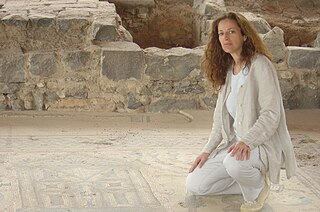 W
WQumran is an archaeological site in the West Bank managed by Israel's Qumran National Park. It is located on a dry marl plateau about 1.5 km (1 mi) from the northwestern shore of the Dead Sea, near the Israeli settlement and kibbutz of Kalya.
 W
WEin Feshkha is a nature reserve and archaeological site on the northwestern shore of the Dead Sea, about three kilometers south of Qumran in the West Bank. Within the reserve is a group of springs of brackish water. The nature reserve consists of an open section with pools of mineral water for bathing surrounded by high foliage and a section that is closed to visitors to protect the native flora and fauna.
 W
WKatharina Galor is a German-born Israeli art historian and archaeologist specializing in Israel-Palestine. She has been teaching at Brown University since 1998, where she is Hirschfeld Visiting Associate Professor of Judaic Studies and Visiting Associate Professor of Urban Studies.
 W
WGerald Lankester Harding was a British archaeologist who was the director of the Department of Antiquities of Jordan from 1936 to 1956. His tenure spanned the period in which the Dead Sea Scrolls were discovered and brought to public awareness. Without his efforts many of the scrolls might have disappeared into private collections never to be seen again.
 W
WYizhar Hirschfeld was an Israeli archaeologist studying Greco-Roman and Byzantine archaeology. He was an associate professor at the Hebrew University of Jerusalem and director of excavations at a number of sites around Israel, including Ramat Hanadiv, Tiberias, and Khirbet ed-Deir. He also published a book on the archaeology of Qumran in which he proposed an assessment of the site that was contrary to prevailing views.
 W
WPaleo-Hebrew Leviticus scroll, known also as 11QpaleoLev, is an ancient text preserved in one of the Qumran group of caves, and which provides a rare glimpse of the script used formerly by the nation of Israel in writing Torah scrolls during its preëxilic history. The fragmentary remains of the Torah scroll is written in the Paleo-Hebrew script and was found stashed-away in a cave at Qumran, showing a portion of Leviticus. The scroll is thought to have been penned by the scribe between the late 2nd-century BCE to early 1st-century BCE, while others place its writing in the 1st-century CE.
 W
WQumran Caves are a series of caves, some natural, some artificial, found around the archaeological site of Qumran in the Judaean Desert of the West Bank. It is in these caves that the Dead Sea Scrolls were discovered.
 W
WRoland Guérin de Vaux was a French Dominican priest who led the Catholic team that initially worked on the Dead Sea Scrolls. He was the director of the Ecole Biblique, a French Catholic Theological School in East Jerusalem, and he was charged with overseeing research on the scrolls. His team excavated the ancient site of Khirbet Qumran (1951–1956) as well as several caves near Qumran northwest of the Dead Sea. The excavations were led by Ibrahim El-Assouli, caretaker of the Palestine Archaeological Museum, or what came to be known as the Rockefeller Museum in Jerusalem.
 W
WWadi Murabba'at, also known as Nahal Darga, is a ravine cut by a seasonal stream which runs from the Judean desert east of Bethlehem past the Herodium down to the Dead Sea 18 km south of Khirbet Qumran in the West Bank. It was here in caves that Jewish fighters hid out during the Bar Kochba revolt, leaving behind documents that include some letters signed by Simon Bar Kochba.